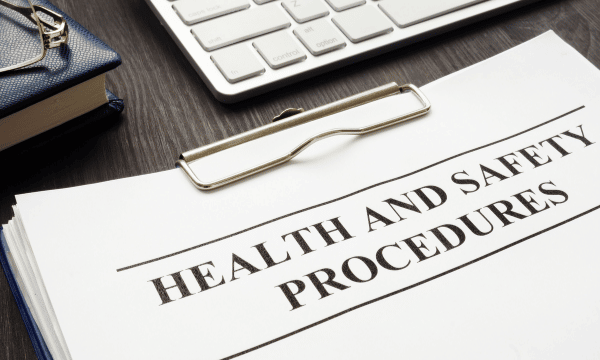What Is A Health And Safety Management System?
We are often asked, what is a Health and Safety Management System? In this article, we explain what a Health and Safety Management System is and briefly outline each of the four stages of this system.
Most employers are aware that if they employ five or more people, a written health and safety policy is a legal requirement. Whilst the policy itself is usually a straightforward statement of the company’s commitment to health and safety, the organisation and arrangements required to convert the intent into actions may be more involved.
These requirements should be implemented in the form of a Health and Safety Management System.
The Health and Safety Executive (HSE) used to advocate a POPIMAR approach (policy, organisation, planning, and implementing, measuring, auditing and review), however a couple of years ago, the document that promoted this approach, Managing for Health and Safety (HSG 65), was radically revised.
The 2013 revision places more emphasis on making the health and safety management system an integral part of how companies manage their daily business rather than treating it as an expensive bolt on measure.
The basis of this new approach is Plan, Do, Check, Act. This method of health and safety management is based on the theory that it is a continuous process, i.e. you do not simply stop managing because you have got to the end of the “Act” process. Each stage overlaps and feeds into the next as your company continually adjusts its processes to improve performance.
This process is covered in detail in our Highfield Level 4 Award in Health and Safety in the Workplace Course.

Stage 1: Plan
When setting the policy:
-
Think about where you are now and where you need to be
-
Set out the company’s aims and objectives for health and safety, who will be responsible for what, how you will achieve your aims, and how you will measure your success
-
Decide how you will measure performance
-
Consider fire and other emergencies and compile a clear plan of how you would deal in the event of such situations arising
-
Plan for changes and identify any specific legal requirements that apply to you
Stage 2: Do
In essence this is about implementing the plan that you have put into place during the previous stage. In doing this you should aim to involve your workers and communicate and ensure that adequate resources are allocated to the plan, including competent advice where needed.
The stages you should go through, broadly speaking, are to:
Put in place the preventive and protective measures needed (as identified in the planning stage)
Provide the right tools and equipment to do the job and keep them maintained
Train and instruct staff, to ensure everyone is competent to carry out their work
Provide adequate supervision to make sure that arrangements are followed
Stage 3: Check
Unless you check what is going on you will not know how effectively your health and safety plans are being implemented. Monitoring and reporting are important parts of health and safety arrangements. When monitoring performance do not just rely on reactive indicators such as accident reports. Whilst lessons can be learned it is better to monitor proactively as well as you may stop incidents happening in the first place.
Proactive measures include:
Make sure that your plans have been implemented by observing working practices.
Assess how well the risks are being controlled and if you are achieving your aims through informal inspections or formal audits.
Encouraging feedback from staff, both good and bad.
Health surveillance.
Reactive measures include:
Investigating the causes of accidents, incidents or near misses.
Monitoring sickness absence.
Dissemination of lessons learned.

Stage 4: Act
Organisations must review their health and safety performance as it tells you whether your system is effective in managing risk and protecting people.
Reviews should include:
Learning from accidents and incidents, ill health data, errors and relevant experience, including from other organisations.
Revisiting plans, policy documents and risk assessments to see if they need updating.
Action plans should include:
Close out actions from audit and inspection reports.
Have names and dates placed next to actions so they do not “fall between the cracks”; it is easy for everyone to assume someone else is doing something.
Finally, the “act” stage then feeds back into the planning process. It may lead to revisions to your policy or procedures if you find a better or more effective way of doing something. It may even help you to streamline your policy if you realise that you have superfluous procedures.
Once your company has gone through one cycle of “Plan, Do, Check, Act” it should then become a more fluid process and benefit your other management procedures. Doing it safely is usually the most efficient way!
What the Law Says
The general management of health and safety is covered by the Health and Safety at Work etc. Act 1974 and the Management of Health and Safety at Work Regulations 1999.
Check out our HSE guide Introduction to the Management of Health and Safety
If you have a question or enquiry about health and safety, please call the team on 01452 502113 or complete our enquiry form.
Find this helpful?
Signup to our email notifications to receive alerts when we publish new blogs. We promise not to spam your inbox, you will just get a short snappy intro to Health and Safety articles we think you will love.
"*" indicates required fields

The Ultimate Fire Safety Checklist
If you’ve got a question or query, please contact our super friendly team, they will be delighted to help you!
Simply get in touch via phone or email.

Free
Resources &
Downloads
Informative. Useful. Practical.
Here at Envesca we believe that we are good at giving proactive, sensible and useful advice. Below you will find some free resources that you can download on a host of subjects that will help you and your business.
Training Available
Envesca offer a number of different training courses, which offer advice and guidance on these topics.





